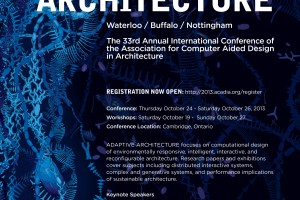
Custom shaped bricks assembled to make a screen wall.
Prototyping Architecture International Conference
Februrary 21-23 2013, London, UK
“Clay, Craft Culture: Material Explorations at Grymsdyke Farm” by Samantha Oswald
The Conference
This conference was hosted by the Building Centre in London, UK. Architects, engineers, and academics with an interest in physical testing and fabrication gathered to share their thoughts on the role of prototyping in design practice and research. “Prototyping Architecture places a particular emphasis on research and experimentation showing how trial assemblies can inform architecture. In post-digital design practice the prototype remains a vital means of design development.”
A PDF of all conference papers can be found here.
The Paper
My presentation focused on my research in brick forming, firing, and assembly that I conducted while at Grymsdyke Farm, UK, as part of my thesis research. I first presented a history of the farm and situated my work within the context of the brick-making tradition in the area. I went on to describe two projects, the first executed in the context of a workshop with fellow University of Waterloo students, and the second constructed as an individual project. The first explored the structural capabilities of masonry tiles through the construction of a Catalan arch, and the second the performance of non-standard brick modules through the construction of a single-occupant shelter. I explained how Grymsdyke Farm is redefining architectural practice through its investment in site, history, and digital fabrication. The paper related very closely to my thesis research on the dialogue between brick and contemporary construction, as well as my broader interest in the value of material (see here).





The molding process.
The Experience
The conference introduced me to the tight-knit community that focuses on fabrication in architecture. I was able to meet and converse with doctoral students, researchers, and professors from the UK and Europe, including representatives from institutions such as the Bartlett school in London, the ETH in Zurich, and the Royal Academy of Fine Arts in Copenhagen. I gained an understanding of current research topics as well as a sense of how my research fits into the theme of prototyping and digital fabrication. I was heartened to see how new methods of construction are finding their way into architectural practice, with lectures by SOMA architects, NEX architecture, and the keynote by Frank Barkow of Barkow Leibinger. Waterloo faculty Philip Beesley was of course an inspiration. I think my favourite presentation, though, was by Manuel Kretzer, who described the importance of free experimentation and handcrafted assembly in the development of smart materials.
I was glad to meet again the students from the Bartlett Institute who we had worked with on the project Archiglace/Inclusions. They came to work with us in Cambridge, so in a kind of exchange I went to visit them in their studio, which is housed in the former Royal Ear Hospital. It’s a large open space furnished only with simple tables, but crowded with prototypes and equipment.
This conference was incredibly rewarding and memorable, and I hope to sustain the contacts I made while attending. At the end, I was allowed to test the 3d printed violin, so I brought some Cape Breton tunes to downtown London!





Leave a Reply